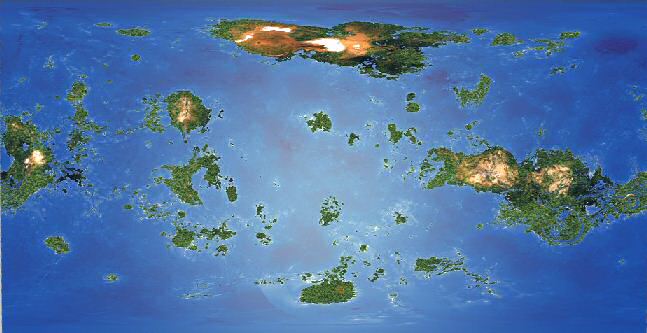Venus
| Go to Calendar page
|
|
| ,1 ,2 ,3 ,4 ,5 , 6 , 7, 8 , 9, 10 | Go to HELP Page |
 |
|||||||||||||||||||||||||||||
| Venus is the second planet from the Sun. | |||||||||||||||||||||||||||||
The surface of Venus consists mainly of plains dotted with eroded craters, presumably formed by meteorite impacts. The largest highland area is Aphrodite Terra near the equator, half the size of Africa. The highest mountains are on the North highland region of Ishtar Terra, where the massif of Maxwell Montes rises to 10,600 metres above the average surface level. The highland areas on Venus were formed by volcanoes, which may still be active. The planet is covered in volcanic features, such as vast lava plains, fields of small lava domes, and large shield volcanoes. Radar observations made by orbiting spacecraft show that the highlands are highly reflective. At Venus's hot lower elevations lead and bismuth would be vaporised and exist as a metallic mist; and on the higher hills, where it is a little cooler, the metal would condense to form a thin, highly reflective `frost` on the ground. Lead and bismuth sulfides snow can be used to date the age of the Venus' using the ratios of different lead isotopes (which differ only in number of neutrons). By all accounts this is a `hellish` place indeed But, there is a controversial idea that microbes may live in the planet's clouds... |
|||||||||||||||||||||||||||||
 to read more. to read more.
 for large colourmap. for large colourmap.  for large bumpmap. for large bumpmap. for more pictures and latest updates (on Forum). for more pictures and latest updates (on Forum).
| |||||||||||||||||||||||||||||
Venus always appears brilliant, and shines with a steady, silvery light. It starts 2006 very low in the west-south-western evening sky at dusk for the first several days of January. It then passes inferior conjunction (between the Sun and the Earth) on January 13 and makes its transition into the morning sky. The planet is low in the east-southeast sky during the final week of January, at the first light of dawn and it will continue to be a prominent morning object right on through the end of August. It will then be hidden again by the bright solar glare almost through the rest of the year. Passing through superior conjunction on October 27, it will then return to the evening sky, though not likely readily visible for most until the waning days of December. During late January and through much of February, it will resemble a beautiful crescent in steadily held binoculars and telescopes. Venus will reach its greatest brilliancy in the morning sky on February 17. Venus will appear to pass very close to Saturn on the morning of August 27; the planets will appear low to the eastern horizon and separated by only about a half-degree (the apparent width of the Moon). |
|||||||||||||||||||||||||||||
 |
The first artificial object to hit another planet was the Soviet probe Venera 3, which crashed on Venus 1 Mar 1966. Later Venera probes parachuted down through the atmosphere and landed successfully on its surface, analysing surface material, and sending back information and pictures. In Dec 1978 a US Pioneer-Venus probe went into orbit around the planet and mapped most of its surface by radar, which penetrates clouds.
Between 1975 and 1981 Soviet probes landed on Venus 10 times.
All the Venera craft survived the landing and four of them sent back images of the inhospitable surface. Because of its reflective atmosphere and proximity to the Sun, Venus shows as the unmistakably bright object in the evening sky. | ||||||||||||||||||||||||||||
 |
 to Check out the transit of Venus! to Check out the transit of Venus! to Download venus map. to Download venus map. for latest information on the Venus Express Spaceprobe. for latest information on the Venus Express Spaceprobe.
| ||||||||||||||||||||||||||||

|
| ||
Return to Solar Database
|